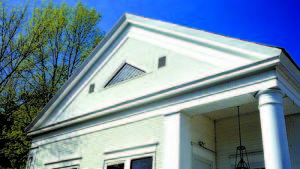Town Hall: Historically significant
By Margaret Reimer
Guest Writer
Voters are facing a vote on June 10 about the fate of Bridgton’s Town Hall. This building is deemed historically significant by the Executive Director of the Bridgton Historical Society, Ned Allen.
The Town Hall is rich in symbolic meaning, particularly since every town meeting has been held within its walls since 1852. The Town Hall symbolizes Bridgton’s commitment to local rule and to the voting rights of its citizens. Initial town meetings, including the vote to incorporate the town in 1794, were held in the Congregational Church, which, at that time, was the only religious denomination allowed in Massachusetts’ towns. By the mid-nineteenth century, the old ways were jettisoned and towns that wanted to be significant started building public-owned buildings, where they could meet to conduct the town’s business. Looking around our neighboring towns reveals that Bridgton is the one town that believed in its future — and in its significance as a community — enough to expend public monies on a municipal building. One had to venture all the way to Fryeburg (quite a distance by horse or foot) to find a similar commitment to a town’s future.
In 1851, the town directed the building of a “Town House†(although not without some acrimonious debate resembling the current discussion about the building) and contracted with William T. Kilborn and Benjamin Walker to complete the work. The wooden structure, modeled along the lines of the typical New England church, utilized local wood products and local craftsmen. The central room featured an arched ceiling and permanently-anchored tiered seating as was appropriate for a building that would be used primarily for conducting town business. It was a symbol that Bridgton had “arrived†as a significant center of commerce. The building might currently look like four wooden sides on a crumbling foundation, but the building also speaks eloquently of the town’s continuing aspirations.
The dedication of the Town Hall on Jan. 8, 1852, was a major community event. Former State Senator Marshall Cram had conducted interviews of the descendants of the early settlers of Bridgton in order to craft an address for the ceremony that would remind Bridgton residents of the difficult journey begun by their ancestors to raise a bustling town in the wilderness of western Maine. The resulting “Cram’s Address†was a local sensation and 32-page reprints of the speech became proud possessions of Bridgton’s households. The Address remains significant even today for its meticulous use of first- and second-hand observations from early residents and for its position as the first written history of the community. It, along with the building it helped to dedicate, helped to mark the importance of the narrative of the town of Bridgton.
By 1902, the building needed repairs and reconfiguration. Selectmen’s offices were added to the back of the building, the permanent seating was eliminated and the original central doors were replaced by an extension to the front of the building that allowed for an off-center entrance with a single Doric column. Columns on buildings suggest solidity and timelessness, but the ever-frugal people of Bridgton apparently balked at the need for more than one such decoration, hence our single pillar. The rededication of the building, after its remodeling, apparently caused a bit of an uproar, as scandalized supporters of the column realized that this piece of embellishment had been installed upside down! The local contractor had apparently been unfamiliar with the architectural style and placed the wide-banded end of the pillar at the top, instead of at the base where it belonged. If you look carefully at the building, you will note that the column’s base continues to remain at the roofline and the structure ever-so-gradually narrows at the base. Through the years, Bridgton has resisted the temptation to “correct†this building error and the upside down column remains in place.
After the 1902 renovations, the building saw increased public use, including being the home-court for the Bridgton Blackhawks. Except during the fall break in usage that allows for resurfacing of the wooden floors, the Town Hall sees daily usage from a broad variety of community organizations, from the Jumping Janes to ping pong tournaments. And it still, despite the years, serves its original purpose as a gathering spot for the exercise of local control, as we enter to cast our votes and have our say in the running of our town.
Bridgton may never have grown to rival Portland in size, but the Town Hall stands as a monument to the aspirations of an earlier generation and the potential of the current one. Demolishing it would be a disservice to the community.
Margaret R. Reimer is the president of the Trustees of Bridgton Historical Society.


